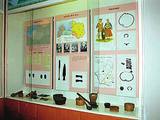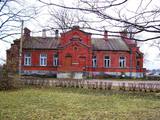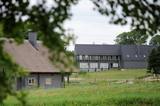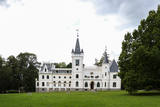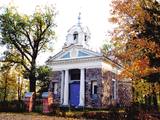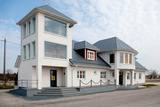| Нo | Название | Описание |
|---|---|---|
|
Piedāvā ļoti gardus Lietuviešu tradicionālos ēdienus. Var pieņemt līdz 80 personām. Pieņem bankas kartes, pieejama autostāvvieta. |
||
|
Вилянский краеведческий музей. В музее есть возможность
познакомиться с историей и культурой края с давних времён до
наших дней. Экскурсии по городу.
Время работы: 8.00 – 12.00,13.00 – 17.00, Сб.,Воскр.: выходные |
||
|
Tūrisma gide Ineta Jansone piedāvā ekskursijas grupām uz Ķemeriem un iepazīstina ar Ķemeru kūrorta vēsturi. Kopš seniem laikiem Ķemeri slaveni ar to, ka šeit ir daudz sērūdeņu avotu un ārstnieciskās dūņas. Šurp brauca ārstēties kopš 19. gs. sākuma. 1838. gadā Ķemeros nodibināja kūrortu. Ķemeru kūrortā ārstēja ādas un kaulu slimības, kā arī gremošanas un nervu sistēmas slimības. 1877.g. izbūvēja dzelzceļa līniju Rīga - Tukums, bet 20.gs. sākumā tika ieviesta tiešā dzelzceļa satiksme ar Maskavu. Kūrorts bija ļoti populārs un katru gadu arvien vairāk viesu brauca šurp ārstēties. Īsi pirms I Pasaules kara atklāja elektriskā tramvaja satiksmi starp Ķemeriem un jūru - Jaunķemeriem. Ķemeri atrodas starp purviem un ezeriem, 6 km attālumā no Rīgas jūras līča. |
||
|
Усадьба Адамова (старое название Adamhof, Odumova). Строительство здания датируется 1851
годом. Владельцами усадьбы были резекненский господин Корф, племянница декабриста
Оболенского Жемчужникова, генерал Караулов. В 1905 году в усадьбе Адамова обнаружили
минеральные источники и назвали в честь Св. Елены. Минеральные воды получили высшие награды
в Лондоне (1912 г.) и Париже (1913 г.). В настоящее время минеральные источники в Адамова уже
не найти. Сохранилось два здания 19 века, которые являются памятниками архитектуры. На
территории усадьбы расположена специализированная школа-интернат. В 2006 году около школы-
интерната был построен современный спортивный комплекс, где организуются спортивные
соревнования государственного масштаба. Комплекс предлагает сауну, конференц-залы, лодки
напрокат и ночлег на 120 персон.
|
||
|
В хозяйстве разводят коз, из молока которых делают сыр и другие продукты. Для посетителей построен презентационный зал, где можно продегустировать мороженое из козьего молока, купить сувениры, связанные с тематикой коз, и другую продукцию. Предлагается экскурсия по хозяйству. |
||
|
Mājas saimniecība „Pie Tēvoča Garika" piedāvā iepazīties ar nelielu dzīvnieku kolekciju. Dažus dzīvniekus var pabarot un paglaudīt. Te iespējams apskatīt gan mājas dzīvniekus, gan savvaļas dzīvniekus. Par katru dzīvnieku sniedzam informāciju. |
||
|
Lauku viensēta ar 8,9 ha lielu teritoriju atrodas Alītas rajonā, netālu no Simnas pilsētas pie gleznaina Atesio ezera Atesninki ciemā.100 m attālumā no ūdens ierīkots viesu nams ar 70 gultas vietām. Piemērota svinību un konferenču rīkošanai līdz 100 personām. Iespēja pašiem gatavot ēst, jo aprīkota ar plašu virtuvi. Lauku sēta radīta gan aktīvai, gan mierīgai atpūtai. Ir basketbola un volejbola laukumi, bērnu rotaļu laukums, dārzs, zvejas būdas, grilla vieta. Bezmaksas izmantojami 4 ūdens velosipēdi, kanoe vai koka laivas. Pirts patīkamai laika pavadīšanai. |
||
|
Neparastais objekts meklējams Teteles pamatskolas parkā, Lielupes labajā krastā. Torni cēlis (dažādas versijas par celšanas gadu: 1840. g. vai 1885. g.) Tetelmindes muižas barons Frīdrihs Bērs, jaunākais, par godu saviem viesiem, kas ieradušies pie barona uz medībām. Tornis kalpojis kā medību skatu tornis un vieta apkārtnes novērošanai. Godinot viesus, tajā uzvilka karogu. Apskatāms no ārpuses. |
||
|
Одно из редчайших мест, где представлен к публичному осмотру характерный для исторического края Селия двор со всей своей планировкой и типичными постройками. «Гулбьи» находятся относительно далеко от крупных дорог и населенных пунктов - на острове Дронка, недалеко от начала древней долины Двиете. Хозяева «Гулбьи» собрали богатую коллекцию старинных хозяйственных и предметов быта. Прибывшие сюда могут ознакомиться с хозяйством, коллекцией лечебных растений, отведать еды селов или посетить баню по-черному. Можно сказать, что в «Гулбьи» люди живут в натуральном хозяйстве, соблюдая и поддерживая традиции исторического края. Латышская кухня: Тонкие блины, суп из перловой крупы, картофельный суп-пюре, тушеная фасоль в особом соусе, буберт, хлебный суп с взбитыми сливками, торты, травяные чаи. Особое блюдо: Цеппелины. |
||
|
Построен в первой половине 19 века, в стиле неоготики Тюдоров. Первым владельцем замка стал барон Иоанн Готлиб фон Вольф. В 70 – 80 годах того же века его перестроили в стиле французского неоренессанса. Во время революции 1905-го годa замок сожгли, однако восстановили, введя в его облик формы модерна. Замок можно осмотреть изнутри, предлагаются экскурсии. |
||
|
«Яунпилс пиенотава» работает уже более ста лет (с 1912-го года) и сырных дел мастера здесь производят полутвердые сыры, мягкие сыры, творог, сметану, десерты и другие молочные продукты. В процессе производства используют только молоко, произведенное латвийскими крестьянами. Продукция экспортируется в более чем 17 стран мира. Продукцию предприятия «Яунпилс пиенотава» можно купить в находящемся рядом с предприятием магазине. |
||
|
Илзескалнская-Кульневская православная церковь
построена в 1832 году владельцем усадьбы Илзенбергс (Илзес-
калнс) Михаилом Кульневым, братом Якова Кульнева. Церковь
представляет собой прямоугольное здание с полукруглыми выступами. Здесь похоронены члены
семьи Кульневых. Место захоронения – уникальный объект посещения, что является редким среди
православных церквей Латвии.
|
||
|
Kadarbiku estate is located in Harju, in the municipality Saue, in the village Tula (Tuula). Agriculture started to work here in 1989, while the family company Kadarbiku Köögivili OÜ was established in 2004. Kadarbik farms specializes in growing and processing vegetables. The farm uses 500 hectares of land, which grows carrots, cabbage, beets and various summer crops. They also make juices and smoothies. |
||
|
Ресторан Agnese приглашает в кругосветное кулинарное путешествие. Местные дары природы и продукты, заботливо доставленные крестьянами, ‒ здесь их приготовят с любовью, подчеркнув их вкус, ценимый латвийцами. В меню также входят всемирно известные рецепты. Об атмосфере уюта в ресторане заботится говорящий попугай Чарли. Каждый найдет здесь не только вкусную еду, но и погрузится в атмосферу праздника. Особое блюдо: Филе судака из озера Буртниеку. |
||
|
В находящемся в порту Сыру Морском центре хранятся различные морские суда, строятся и реновируются небольшие деревянные лодки. В порту ждет реставрации трехмачтовый парусник "Alar". В здании музея, который входит в комплекс морского центра, развернута постоянная экспозиция о местной морской культуре, есть возможность заказать тематические учебные семинары о прибрежных культурах. |
||
|
This is an uncommon trail. The visitor will learn all about quite “ordinary” trees such as the oak, the linden, the hazelnut, the fir and the pine. The information is quite interesting, however, making use of the heritage of Latvian folklore. The site is located near the Zvārte rock. Visitors will spend around one hour on the trail.
|
||
|
This is the 11th largest Estonian island, and its central section is covered by a broadleaf forest (linden, oak, elm and other trees) that is more than 100 years old. Along the shores, the Abruka Island has meadows and small areas of wetlands. Only the northern part of the island is populated. Few tourists come to call, which means that the island is relatively untouched by humankind.
|
||
|
Puises ragā (Puise nina) ir uzcelts divstāvīgs atpūtas nams, kas apvienots ar putnu vērošanas torni. No tā paveras skats uz piekrasti, kas ir iecienīta migrējošo zosu atpūtas vieta. Šī ir privāta teritorija, kuras apskati vēlams saskaņot ar īpašnieku. |
||
|
Jelgavas pils dienvidaustrumu spārna cokolstāvā ir iepazīstamas Kurzemes un Zemgales valdnieku - Ketleru un Bīronu dzimtas kapenes (laika posms no 1569. – 1791. g.), kur apskatāmi 18 restaurētie sarkofāgi. Šī ir Baltijas mērogā nozīmīga vieta, kas noteikti jāapmeklē ikvienam vēstures interesentam. |
||
|
Atrodas pie Līvānu dzelzceļa stacijas, Dzelzceļa ielā 17. Tā kā Līvānos nebija luterāņu baznīcas, draudze dievkalpojumus noturēja ugunsdzēsēju depo. 1929. gadā ielika dievnama pamatakmeni un pēc trīs gadiem pabeidza pašas ēkas celtniecību. Saglabājušās ziņas, ka padomju laikā baznīcā bija plānots iekārtot sporta zāli un noliktavu, taču tas neticis īstenots. Jāpiemin, ka baznīca ir celta uz bijušās korķu fabrikas pamatiem. Dievnama zvana iegādei līdzekļus sarūpēja kara ministrs – ģenerālis Jānis Balodis u.c. |
||


